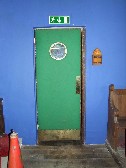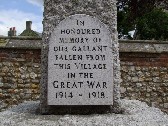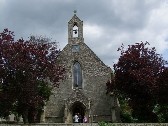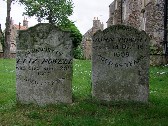| |
|
All
Saints, Stoke Ferry Not many people visit Stoke Ferry
these days, I suppose. The main road between Thetford and
Lynn used to go through it, but now all traffic is
carried past by a fast, wide bypass, and travellers
hurtle along without even realising that the village is
there. This is a shame, because Stoke Ferry, while hardly
one of Norfolk's more attractive villages, is a most
interesting place, the kind of village more common in
Cambridgeshire than in Norfolk or Suffolk. Its huge
growth in the 19th century was as a result of
agri-industrial development, and it still retains
something of this character today. Not far off are the
pretty villages of Boughton, Wherrington, Wretton and
Wereham, almost rural suburbs of a kind; Stoke Ferry is
not pretty. The biggest employer is the Wissington sugar
beet factory, and the tall chimney of a factory rather
dominates the place. But even with the bypass, it still
feels busy and purposeful, as if it is the centre of
something, and I liked it for that.
The
rebuilding of All Saints dates from the period of this
expansion, a time of considerable optimism in the Church
of England; in retrospect, it can be seen as a time when
that denomination over-stretched itself somewhat. The
church had been near-derelict at the start of that
century: the tower had collapsed in the 1570s, and the
chancel was taken down a century later. The Georgian
porch and clock were added in the 1820s, but the bulk of
the rebuilding was in 1848 by an architect called
Donthorn. This is still early for Norfolk, thus the
pre-Ecclesiological feel. There are three medieval
churches within a couple of miles, as well as another
Victorian one, and so today All Saints is redundant. It
is in private ownership, but it is used regularly by the
local community for exhibitions, concerts and other
functions.
We arrived
in Stoke Ferry to find that there was an art exhibition
on, the cleared nave full of display boards. I think the
nice lady on the door knew straight away that we weren't
there for the pictures, but she didn't seem to mind, and
was very welcoming. And so we wandered around this small,
crisp church.
| The
nave is full of light, the windows large and the
tracery in a flamboyante style. Flamboyante,
literally 'blazing flame', was what the French
had when we had Perpendicular, and it was popular
with Gothick architects of the early 19th
Century. The pale coloured glass in an Art
Nouveau style in the upper lights must be later.
Interestingly, Pevsener says that these patterns
were also to be found on the font, but this is
now gone. The other striking feature of the nave
is the set of painted shields decorated with
heraldic devices. The chancel is slightly
surreal. Although the part of the church which is
most recognisably church-like, the priest door
has been replaced with a cinema-style emergency
exit door, with toilets beyond. The east window
is filled with good glass from a Norwich
workshop, the side windows with rather more
workaday Saints by Heaton, Butler & Bayne.
The church must have been given a serious going
over in the 1860s as well. Turning west, the area
above the entrance is filled with a good
mezzanine gallery. I am told that the radio
personality Kit
Hesketh-Harvey, the good-hearted owner of this
church, uses it as his office.
|
|
 |
|
|
|



